Audrey Munson
Audrey Marie Munson (June 8, 1891 – February 20, 1996) was an American artist's model and film actress, today considered "America's First Supermodel."[1] In her time, she was variously known as "Miss Manhattan", the "Panama–Pacific Girl", the "Exposition Girl" and "American Venus." She was the model or inspiration for more than twelve statues in New York City, and many others elsewhere. Munson also appeared in four silent films, including Inspiration (1915) in which she appeared nude, one of the first American actresses to do so in a non-pornographic film.
Audrey Munson | |
|---|---|
 Munson with Buzzer the cat in 1915 | |
| Born | Audrey Marie Munson June 8, 1891 Rochester, New York, U.S. |
| Died | February 20, 1996 (aged 104) Ogdensburg, New York, U.S. |
| Resting place | New Haven Cemetery |
| Nationality | American |
| Occupation | Artist's model, actress |
| Years active | 1906–1921 |
Career
Long after she and everyone else of this generation shall have become dust, Audrey Munson, who posed for three-fifths of all the statuary of the Panama–Pacific exposition, will live in the bronzes and canvasses of the art centers of the world.
— Richmond (Virginia) Times-Dispatch, August 1, 1915[2]

Model
Audrey Marie Munson was born in Rochester, New York, on June 8, 1891,[4][3]:12 to Edgar Munson and Katherine "Kittie" Mahaney. Her father was from Mexico, New York, and she later lived there. Her parents divorced when she was eight, and Audrey and her mother moved to Providence, Rhode Island.[5]
In 1909 the pair moved to New York City, where the 17-year-old Audrey sought a career as an actress and chorus girl.[1] Her first role on Broadway was as a "footman" in The Boy and The Girl at the Aerial Gardens of the New Amsterdam Theatre, which ran from May 31 – June 19, 1909.[6] She also appeared in The Girl and the Wizard, Girlies and La Belle Paree.[6]

While window-shopping on Fifth Avenue with her mother she was spotted by photographer Felix Benedict Herzog, who asked her to pose for him at his studio in the Lincoln Arcade Building on Broadway and 65th Street.[1] Herzog introduced her to his friends in the art world. She posed for muralist William de Leftwich Dodge, who gave her a letter of introduction to Isidore Konti. Konti was her first sculptor, and her first nude modeling.[7] From this point Munson would pose for a few well-known visual artists, including painter Francis Coates Jones, illustrators Harrison Fisher, Archie Gunn, and Charles Dana Gibson,[8] and photographers Herzog and Arnold Genthe,[1]:29, 43 but she was predominantly a sculptors' model.
Munson's first acknowledged credit is Konti's marble statuary called Three Graces unveiled in the new Grand Ballroom at the Hotel Astor in Times Square in September 1909.[1] She posed for all three graces. Soon after, and for the next decade, Munson became the model of choice for the first tier of American sculptors, posing for a long list of freestanding statuary, monuments, and allegorical architectural sculpture on state capitols and other major public buildings. According to The Sun in 1913, "Over a hundred artists agree that if the name of Miss Manhattan belongs to anyone in particular it is to this young woman."[9] By 1915, she was so well established that she became Alexander Stirling Calder's model of choice, when he became Director of Sculpture for the Panama–Pacific International Exposition held in San Francisco that year. Her figure was "ninety times repeated against the sky" on one building alone, atop the colonnades of the Court of the Universe, roughly modeled on St. Peter's Square in the Vatican.[10] In fact, Munson posed for three-fifths of the sculpture created for the event[2] and earned fame as the "Panama–Pacific Girl".[11]
Film actress
Munson's newfound celebrity helped launch her career in the nascent film industry and she starred in four silent films. In the first, Inspiration (1915), made by the Thanhouser Film Corporation in New Rochelle, New York and directed by George Foster Platt, she appeared fully nude in a story of a sculptor's model. The censors were reluctant to ban the film, fearing they would also have to ban Renaissance art. Munson's films were a box office success, although the critics were divided.[3]:81–82 Thanhouser hired a lookalike named Jane Thomas to do Munson's acting scenes, while Munson did the scenes where she posed nude.[12] Although Munson's appearance in Inspiration is sometimes said to be the first occasion of an American actress appearing nude in a non-pornographic film,[13] according to film historian Karen Ward Mahr, it was actually Margaret Edwards who did so in Hypocrites, which was released earlier in 1915.[14]
Munson's second film, Purity (1916), made by the American Film Company in Santa Barbara, California and directed by Rae Berger, is the only one of her films to survive, being rediscovered in 1993 in a "pornography" collection in France and acquired by the French national cinema archive.[1] Her third film, The Girl o' Dreams, also made by American in Santa Barbara and probably directed by Tom Ricketts from a story by William Pigott (the American Film Institute catalog lists Pigott as director, but all his other credits list him as a writer), was completed by the fall of 1916, but although the film is mentioned on the credit lists of several of its actors in the October 21, 1916 Motion Picture Studio Directory it was not released at that time and was not even copyrighted until December 31, 1918; there is no subsequent mention of the film and it may never have been released.[15][16]
Munson returned to the East Coast by train via Syracuse in December 1916, having been involved with high society in New York and Newport, Rhode Island. There are accounts where her mother insists she married the son of a "Comstock Lode" silver heir, Hermann Oelrichs Jr., then the richest bachelor in America. There is no record of this. On January 27, 1919, she wrote a rambling letter to the US State Department denouncing Oelrichs as part of a pro-German network that had driven her out of the movie business. She said she planned to abandon the United States to restart her movie career in England.[1][17]
Notoriety

In 1919 Audrey Munson was living with her mother in a boarding house at 164 West 65th Street, Manhattan, owned by Dr. Walter Wilkins. Wilkins fell in love with Munson, and on February 27 murdered his wife, Julia, so he could be available for marriage.[13] Munson and her mother left New York, and the police sought them for questioning. After a nationwide hunt, they were located. They refused to return to New York, but were questioned by agents from the Burns Detective Agency in Toronto, Ontario, Canada. The contents of the affidavits they supplied have never been revealed, but Audrey Munson strongly denied she had any romantic relationship with Dr. Wilkins.[1] Wilkins was tried, found guilty, and sentenced to the electric chair. He hanged himself in his prison cell before the sentence could be carried out.[18]
As a direct consequence or not, the Wilkins killing marked the end of Munson's ten-year modeling career. She continued to seek regular newspaper coverage. By 1920 Munson, unable to find work anywhere, was reported as living in Syracuse, New York, supported by her mother, who sold kitchen utensils door to door. In November 1920 she was said to be working as a ticket-taker in a dime museum.[19]

From January through May 1921 a series of twenty serialized articles ran in Hearst's Sunday Magazine in dozens of Sunday newspaper supplements,[20][21] under Munson's name, the whole series entitled By the 'Queen of the Artists' Studios'. The twenty articles relate anecdotes from her career, with warnings about the fates of other models. In one she asked the reader to imagine her future:[13]
What becomes of the artists' models? I am wondering if many of my readers have not stood before a masterpiece of lovely sculpture or a remarkable painting of a young girl, her very abandonment of draperies accentuating rather than diminishing her modesty and purity, and asked themselves the question, "Where is she now, this model who was so beautiful?"
In February that year, agent-producer Allen Rock took out advertisements showing a $27,500 check he said he had paid Munson to star in a fourth film titled Heedless Moths, directed by Robert Z. Leonard from his own screenplay based on these writings. She later said the $27,500 check was just a "publicity stunt," and she filed suit against Allen Rock.[1] Those proceedings revealed that the twenty articles had been ghostwritten by journalist Henry Leyford Gates.[22]
In the summer of 1921 Munson conducted a nationwide search, carried by the United Press, for the perfect man to marry. She ended the search in August claiming she didn't want to get married anyway.[23] On October 3, 1921 she was arrested at the Royal Theater (later the Towne Theater) in St. Louis on a morals charge related to her personal appearance with the film Innocence (the reissue title of Purity), in which she had a leading role.[24] She and her manager, independent film producer Ben Judell,[25] were both acquitted. Weeks later she was still appearing in St. Louis, along with screenings of Innocence, enacting "a series of new poses from famous paintings".[26]
On May 27, 1922, Munson attempted suicide by swallowing a solution of bichloride of mercury.[27]
Final years
On June 8, 1931, her mother petitioned a judge to commit her to a lunatic asylum. The Oswego County judge ordered Munson be admitted into a psychiatric facility for treatment. She remained in the St. Lawrence State Hospital for the Insane in Ogdensburg, where she was treated for depression and schizophrenia, for 65 years, until her death at the age of 104.[13][28]
In the mid-1950s Munson was sufficiently famous to serve as the subject of an anecdote in a memoir that P.G. Wodehouse and Guy Bolton wrote of their years on Broadway, Bring on the Girls! (1953), though that memoir is considered more fiction than fact by Wodehouse's biographer.[29][lower-alpha 1]
For decades she had no visitors at the asylum, but she was rediscovered there by a half-niece, Darlene Bradley, in 1984, when Munson was 93.[1] Several years after suffering a stroke, Munson died on February 20, 1996, at the age of 104.[31] She was cremated and her ashes were buried without a gravestone of her own in the Munson family plot in New Haven Cemetery, New Haven, New York.[32] In 2016, 20 years after her death, her family decided to add a simple tombstone for what would have been her 125th birthday.[33]
Sculptures of Munson
The entries below are mentioned in at least one credible source. Coverage of Munson's career, and the works attributed to her modelling work, contained inaccuracies during her lifetime, some of which have been perpetuated more recently. Munson herself was inconsistent about her age and other matters. For instance, a June 1915 article listed the 24-year-old Munson's age as 18,[11] and an August 1915 press release claimed that she'd started posing at age 14.[2] The latter would have been four years prior to her first admitted modeling credit, Konti's Three Graces group at the Hotel Astor, unveiled to the public in September 1909 (when she was 18).
| Key: |
|---|
| Attributed works for which Munson was too young to have posed |
| Works for which Munson confirmed she posed |
| Works attributed to Munson, but without direct evidence |
| Panama-Pacific International Exposition |
| Sculptor | Title | Image | Year | Location/GPS Coordinates | Material | Height | Notes |
|---|---|---|---|---|---|---|---|
| Herbert Adams | The Three Graces[8] | 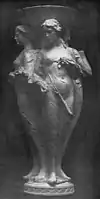 |
1912 | James McMillan Fountain, McMillan Reservoir, Washington, D.C. |
bronze | 12 ft (3.7 m) (overall) |
 1941 expansion of McMillan Reservoir. The pieces spent decades in storage, and suffered vandalism. Only the central figures and upper basin remain.[34] |
| Priestess of Culture[35] | 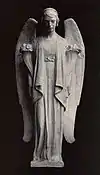 |
1914 | Rotunda, Palace of Fine Arts, Panama-Pacific International Exposition |
staff | 51.5 in (131 cm) | Adams was awarded a PPIE Medal of Honor for his sculpture.[36]:229.jpg.webp)  inside the Rotunda of the Palace of Fine Arts. Those now in place are reproductions. The two surviving original figures are in the collection of the Exploratorium. | |
| Robert Ingersoll Aitken | Greenhut Mausoleum door[37] |  |
1913 | tomb of merchandiser Joseph Greenhut, Salem Fields Cemetery, Brooklyn, New York City |
bronze | Stone, Gould & Farrington, architects | |
| Gates Mausoleum door[38] | 1913 | John Warne Gates Mausoleum, Woodlawn Cemetery, Bronx, New York City |
bronze | Stone, Gould & Farrington, architects[39] Aitken was awarded a PPIE silver medal for his sculpture.[36]:230 | |||
| Panama-Pacific $50 U.S. Gold Coin[40] |  |
1915 | |||||
| The Elements: Air |  |
1915 | Flanking stairs to sunken garden, Court of the Universe, Panama-Pacific International Exposition |
staff | |||
| The Elements: Earth |  | ||||||
| Fountain of the Earth |  |
1915 | Court of the Universe, Panama-Pacific International Exposition |
staff |   | ||
| Karl Bitter | Venus |  |
c.1895 | Library, Biltmore Estate, Asheville, North Carolina |
steel | Bitter modeled a Venus statuette as an andiron figure for Biltmore in the 1890s.[lower-alpha 2] A life-sided Venus Coming from the Bath was photographed in Bitter's studio in 1901.[43] | |
| Venus de Milo (with arms) | by 1921 | Noordeinde Palace, The Hague, Netherlands |
marble | Queen Wilhelmina of the Netherlands commissioned a Venus de Milo (with arms) from Bitter. Munson wrote that Bitter experimented with different arrangements of the arms, modeled the sculpture in clay, and carved it in marble himself.[44] | |||
| Peace[45] |  |
1896–1900 | Appellate Division Courthouse of New York State, 35 East 25th Street, Manhattan, New York City |
Bitter completed his work on the Appellate Courthouse in June 1899,[46] about the time Munson turned 8 years old. | |||
| Peace |  |
by 1921 | Munson wrote that she posed for Bitter for a sculpture of Peace (pictured), but it was not the Appellate Courthouse work.[44] | ||||
| Liberty Supported by the Law[8][47] |  |
1906–1910 | East Pediment, Wisconsin State Capitol Madison, Wisconsin |
Bethel Vermont granite |
96 in (240 cm) | ||
| Bas relief: Diana[44] | c.1910? | Ballroom, George Jay Gould I Mansion, Manhattan, New York City |
marble |  bronze of Diana: | |||
| Pomona or Abundance[48] |  |
plaster 1898, 1915 bronze 1916 (by Konti) |
Pulitzer Fountain, Grand Army Plaza, Manhattan, New York City |
bronze | plaster 24 in (61 cm) bronze 84 in (210 cm) |
 the time of Bitter's April 9, 1915 death.[49] Bitter's widow asked Isidore Konti to complete the work, which was dedicated in May 1916.[49] Munson was publicly credited as the model for Pomona as early as August 1916.[50] Actress Doris Doscher (1882–1970) later claimed to have been the model for Pomona.[51] (Bitter may have used more than one model, or Konti may have used a different model.) | |
| Alexander Stirling Calder | Star Maiden[52] |  |
1915 | Panama-Pacific International Exposition Oakland Museum Oakland, California |
bronze | 48 in (120 cm) | .jpg.webp) .jpg.webp) roof balustrade figure surrounding the Court of the Universe and the Colonnade of Stars: |
| Flower Girl[53] |  |
1915 | Court of Flowers, Panama-Pacific International Exposition |
staff |  colonnade of the Court of Flowers. Edgar Walter's Beauty and the Beast Fountain is in the foreground. | ||
| Enterprise Crowning figure |
 |
1915 | The Nations of the West, atop Arch of the Setting Sun, Panama-Pacific International Exposition |
staff |   Arch of the Setting Sun: | ||
| The Mother of Tomorrow[54]:opp. 22 Central figure |
 |
||||||
| Eastern Hemisphere (reclining female nude with the head of a lioness, east side of the globe) |
 |
1915 | Fountain of Energy, Panama-Pacific International Exposition |
staff | .jpg.webp)   | ||
| The Atlantic Ocean (F. G. R. Roth modeled the dolphin)[55] |
 |
||||||
| The Pacific Ocean (F. G. R. Roth modeled the manatee)[55] |
 |
||||||
| Nereid No. 1,[56] No. 2 and No. 3 (F. G. R. Roth modeled the dolphins)[55] Three nereids riding dolphins, repeated (as a group) four times around the fountain's basin. A water jet spouted from each dolphin's mouth. |
  |
||||||
| Caryatid[57] (John Bateman assisted on this work)[58]:44 |
 |
1915 | Attic of Colonnade (above each column), Court of Palms, Panama-Pacific International Exposition |
staff | .jpg.webp) | ||
| Ulric Ellerhusen | Wonderment[59] |  |
1915 | exterior of Rotunda dome, Palace of Fine Arts, Panama-Pacific International Exposition |
staff | 23 ft (7.0 m) | .jpg.webp)  and Wonderment (female), flank the relief panels on each face of the Rotunda's dome.[58] The figures were recast in cast stone by Spero Anargyros in 1969.[60] |
| Consolation[58]:160 (Weeping Maidens or Drooping Maidens) |
 |
Pergola of the Palace of Fine Arts, Panama-Pacific International Exposition |
"In the goddesses atop the towers and minarets and in the Grecian boxes adorning the Roman columns of the Palace of the Fine Arts will be found the enchanting line of the [Munson's] girlish form."[2] | ||||
| Garland figures[58]:162 |  |
Peristyle Walk, Palace of Fine Arts, Panama-Pacific International Exposition |
A set of five larger-than-life, high-relief figures, repeated around the four semi-circular, ground-level planters | ||||
| John Flanagan | Medallion: Head of Audrey Munson[61]:435 | 1915 | Palace of Fine Arts, Panama-Pacific International Exposition |
bronze | Flanagan was awarded a PPIE Medal of Honor for his sculpture.[36]:234 | ||
| Medal of Award, Panama-Pacific International Exposition[62] |
 |
1915 | bronze | 2.76 in (70 mm) |  | ||
| Daniel Chester French | Mourning Victory[lower-alpha 3] |  |
1906–1908 | Melvin Memorial,[63] Sleepy Hollow Cemetery, Concord, Massachusetts |
Tennessee marble | 115 in (290 cm) |  three brothers who fought and died in the American Civil War.[64] |
| Mourning Victory[65] (mirror image of the Melvin Memorial)[66]:335 |
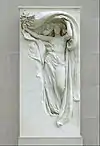 |
carved 1912–1914 |
Metropolitan Museum of Art, Manhattan, New York City |
marble | 120.5 in (306 cm) |  funded the carving of a mirror-image marble version, and donated it to MMA.[67] MMA also owns a bronze cast of Victory's head.[68] | |
| Memory[69] |  |
modeled c.1909 carved 1917–1919 |
Metropolitan Museum of Art, Manhattan, New York City |
marble | 57.5 in (146 cm) | _-_studio_interior.JPG.webp) and studio in Stockbridge, Massachusetts. (Pictured, center) | |
| Jurisprudence[70] |  |
1910–1912 | Metzenbaum United States Courthouse, Cleveland, Ohio |
marble | 12 ft (3.7 m) |  Superior Avenue façade. | |
| Commerce[71] | 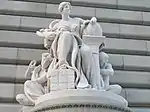 |
1910–1912 | marble | 12 ft (3.7 m) | |||
| Wisconsin (Forward)[72] |  |
1912 | Wisconsin State Capitol, Madison, Wisconsin |
gilded bronze | 15.5 ft (4.7 m) |  | |
| Evangeline[73][74] (bas relief figure, 2nd from right) |
 |
1912–1914 | Henry Wadsworth Longfellow Memorial, Longfellow Park, Cambridge, Massachusetts |
marble | 36 in (91 cm) | 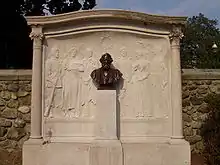 | |
| The Spirit of Life[75] |   |
1913–1915 | Spencer Trask Memorial, Congress Park, Saratoga Springs, New York |
bronze | 122 in (310 cm) |   size working model are in the collections of: Smithsonian American Art Museum,[76] Indianapolis Museum of Art,[77] Newark Museum, Newark, New Jersey,[78] Brooks Memorial Library, Brattleboro, Vermont,[79] and elsewhere. | |
| The Genius of Creation Eve[lower-alpha 4] |
 .jpg.webp) |
1915 | West entrance to Palace of Machinery, Panama-Pacific International Exposition |
staff | French was awarded a PPIE Medal of Honor for his sculpture.[36]:235 _-_studio_interior.JPG.webp) A plaster model is at Chesterwood,[80] French's home and studio in Stockbridge, Massachusetts: | ||
| Brooklyn[81] |  |
1916 | Brooklyn Museum, Brooklyn, New York City |
granite | The pair were created to adorn the Brooklyn side of the Manhattan Bridge. Relocated to exterior of the Brooklyn Museum, 1963. At least some of the modeling for the Brooklyn figure was done by Rosalie Miller.[82] | ||
| Manhattan[83] |  |
1916 | granite | ||||
| Sherry Edmundson Fry | 70th Street pediment[8] |  |
1913 | Frick Mansion, Fifth Avenue & East 70th Street, Manhattan, New York City |
Bedford blue limestone |
||
| Maidenhood[84] | 1914 | Brookgreen Gardens, Murrells Inlet, South Carolina |
bronze | 67.3 in (171 cm) | Ex collection: Metropolitan Museum of Art[35] | ||
| Peace (Maidenhood) |  |
1914–1915 | Peristyle Walk, Exterior of Palace of Fine Arts, Panama-Pacific International Exposition |
bronze | Fry was awarded a PPIE silver medal for his sculpture.[36]:235 | ||
| Cartouche | 1915 | Female nude beside shield, over great arched window of Festival Hall,[54]:125 Panama-Pacific International Exposition |
staff |  | |||
| Flora[85] |  |
Twin figures atop pedestals at base of pylons of Festival Hall,[54]:125 Panama-Pacific International Exposition |
|||||
| Torch Bearer |  |
Figure repeated atop the four corner domes of Festival Hall,[54]:125 Panama-Pacific International Exposition |
|||||
| Reclining Woman (Listening Woman) Pylon figure |
 |
atop east pylon of Festival Hall,[54]:125 Panama-Pacific International Exposition |
|||||
| Ceres, Goddess of Agriculture[86] | 1921 | Missouri State Capitol, Jefferson City, Missouri |
bronze | 124 in (310 cm)[87] |  | ||
| Carl Augustus Heber | Spirit of Commerce[88] |  |
1909–1914 | Manhattan Bridge (south pier), Manhattan, New York City |
granite | ||
| Relief tablet over entrance | 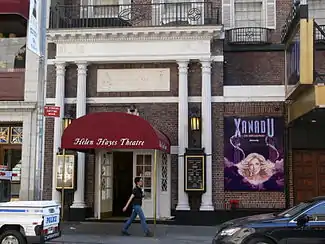 |
c.1912 | The Little Theatre (now Helen Hayes Theatre), 238 West 44th Street, Manhattan, New York City |
marble | _(14786378023).jpg.webp) | ||
| Albert Jaegers | Harvest (Nature) |  |
1915 | atop Half-Dome, Court of the Four Seasons, Panama-Pacific International Exposition |
staff | Jaegers was awarded a PPIE bronze medal for his sculpture.[36]:237 | |
| Sunshine Rain |
  |
atop columns flanking the Half-Dome, Court of the Four Seasons, Panama-Pacific International Exposition |
|||||
| The Feast of Sacrifice[89] |  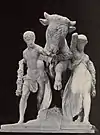 |
Heroic-sized group, repeated twice atop pylons above Forecourt of Ceres, Court of the Four Seasons, Panama-Pacific International Exposition |
 | ||||
| Augustus Jaegers[61]:435 | Abundance[90] Attic figures |
 |
1915 | Court of the Four Seasons, Panama-Pacific International Exposition |
staff |  attic and spandrel figures on the arcades in the Court of the Four Seasons.[91] Abundance was repeated sixteen times on the arcades. | |
| Isidore Konti | The Three Graces |  |
c.1909 | marble |  opened September 29, 1909 (second balcony): At the other end of the ballroom, a companion marble group called The Song featured similar figures, possibly also modeled by Munson.[49]:plate 26 | ||
| Three Muses[92] | .jpg.webp) |
undated | Hudson River Museum, Yonkers, New York |
plaster | 23 in (58 cm) | ||
| Mother and Child: The Bath (Fountain Group)[35] |
 |
c.1910 | private collection | marble | two-thirds life size[49]:plate 35 |
||
| Solace[8][93] | 1911 | Hudson River Museum,[49]:plate 46 Yonkers, New York |
plaster | 28 in (71 cm) | |||
| Fame and Victory (relief figures)[49]:plate 51 |  |
c.1915 | Column of Human Progress, Forecourt of the Stars, Panama-Pacific International Exposition |
staff | .jpg.webp) surrounded the base of the 180 ft (55 m)-tall Column of Human Progress.[49]:plate 51 Munson was the model for Fame and Victory, which flanked the entrance to its vault.[49]:plate 51 | ||
| Pomona |  |
1915–1916 | Pulitzer Fountain, Grand Army Plaza, Manhattan, New York City |
bronze | 84 in (210 cm) | _-_2.JPG.webp) following Bitter's death in April 1915. Konti enlarged it from a 24 in (61 cm) maquette, added detail, and made minor changes. His full-size plaster model was completed in January 1916, approved by Bitter's widow in February, and sent to the foundry in March. The fountain was dedicated in May 1916.[49]:plate 64 | |
| Evelyn Beatrice Longman | Consecration (L'Amour)[94][35] |  |
modeled 1909–1912 carved 1914 |
Wadsworth Athenaeum, Hartford, Connecticut |
marble | 36 in (91 cm) | Exhibited in the Palace of Fine Arts at the 1915 Panama-Pacific International Exposition. Longman was awarded a PPIE silver medal for her sculpture.[36]:239 |
| Fountain of Ceres |  |
1915 | Forecourt, Court of the Four Seasons, Panama-Pacific International Exposition |
staff |  | ||
| Augustus Lukeman | Memory[95] Titanic Memorial |
 |
1913–1914 | Straus Memorial, Straus Park, West 106th Street (west of Broadway), Manhattan, New York City |
bronze | 36 in (91 cm) |  in the 1912 sinking of the RMS Titanic. The park and memorial were dedicated on April 15, 1915, the third anniversary of the sinking. |
| Frederick MacMonnies | Beauty[96] |  |
c.1911–1917 | New York Public Library Main Branch, Fifth Avenue at East 41st Street, Manhattan, New York City |
Carrara marble | 120 in (300 cm) |  Munson wrote that MacMonnies used her for the legs, and another model for the torso and face.[lower-alpha 5] |
| Allen George Newman | Mermaid (unlocated) |  |
1910 | Music of the Waters Fountain (demolished),[98] Riverside Drive at 156th Street, Manhattan, New York City |
marble | "Up on Riverside Drive, Allen George Newman's fountain 'Music of the Water' shows another pose of this young woman."[99] | |
| The Triumph of Peace[100] |  |
1911 | Peace Monument, Piedmont Park, Atlanta, Georgia |
bronze | 108 in (270 cm) |  | |
| Florida's Tribute to the Women of the Confederacy[101] |
 |
1914–1915 | Confederate Park, Jacksonville, Florida |
bronze | seated figure 42 in (110 cm) flagbearer 13 ft (4.0 m) |
 monument.[lower-alpha 6] She also may have posed for the young mother reading to her children. | |
| Attilio Piccirilli | Columbia Triumphant[8] | _Monument_Columbus_Circle_NYC_Columbia_Triumphant.JPG.webp) |
1901–1913 | USS Maine National Monument,[102] Central Park, Manhattan, New York City |
gilded bronze | 16.5 ft (5.0 m) |   |
| Peace[8] |  |
marble | |||||
| Duty[8] |  |
1910–1913 | Firemen's Memorial, Riverside Park, Riverside Drive at West 100th Street, Manhattan, New York City |
Knoxville marble |  | ||
| Sacrifice[8] |  |
||||||
| A Soul (Alone?[3] Widowhood?)[lower-alpha 7] |
1915 | Exhibited outside Palace of Fine Arts, Panama-Pacific International Exposition |
marble | Piccirilli was awarded a PPIE gold medal for his sculpture.[36]:241 | |||
| Sapientia (Wisdom)[8] | 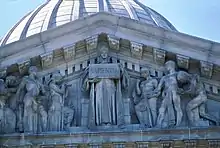 |
completed 1917 |
Learning of the World (north pediment), Wisconsin State Capitol, Madison, Wisconsin |
Bethel white granite | 96 in (240 cm) |  | |
| Furio Piccirilli | Eurydice[104]:512 |  |
1911 | Exhibited outside Palace of Fine Arts, Panama-Pacific International Exposition |
marble | Piccirilli was awarded a PPIE silver medal for his sculpture.[36]:241 | |
| Summer |  |
1915 | Court of the Four Seasons, Panama-Pacific International Exposition |
staff |  by a colonnade, and set upon a curved stepped base, down which water cascaded. | ||
| Autumn |  |
 | |||||
| Winter | 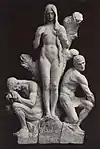 |
 | |||||
| Spring (Munson posed for both the female figures)[105] |
 |
 | |||||
| Edmond Thomas Quinn | Audrey[106][107] | 1915 | Exhibited at Palace of Fine Arts, Panama-Pacific International Exposition |
freestanding bronze | Quinn was awarded a PPIE silver medal for his sculpture.[36]:242 | ||
| Ulysses Ricci | Portrait of Miss Audrey Munson[108] | 1914 | whereabouts unknown | bronze[109] | Exhibited at National Academy of Design in 1914 Exhibited at Syracuse Museum of Fine Arts[109] | ||
| Frederick Ruckstull | Monument to South Carolina Women of the Confederacy[110] |
 |
1909–1912 | South Carolina State House, Columbia, South Carolina |
bronze | 14 ft (4.3 m) | |
| Salvatore Cartaino Scarpitta | Lady Godiva | by 1914 | unknown | silver | "Even on Fifth avenue you will find her at a famous silversmith's sitting dejectedly on a white horse as Lady Godiva in a beautiful piece of work made by Scarpetti [sic]."[8] | ||
| The Light That Failed[73] |  |
1915 | |||||
| Starlight[73] | c.1915 | Collection of John D. Rockefeller, Jr. (1921) |
|||||
| Maidenhood[111] | by 1921 | Collection of Henry Clay Frick (1921) | |||||
| Francois Tonetti | Water Nymph[7] | by 1921 | Kykuit (John D. Rockefeller Estate) Pocantico Hills, New York |
||||
| Edgar Walter | Beauty and the Beast |  |
1915 | Beauty and the Beast Fountain, Court of Flowers, Panama-Pacific International Exposition |
staff |  | |
| Adolph Alexander Weinman | Day and Night Pair of figures flanking the exterior clocks, repeated over the station's four main entrances. The station was demolished, 1963-1966. |
_(14759502262).jpg.webp)   |
c.1910 | Pennsylvania Station, (bordered by 31st Street, 7th Avenue, 33rd Street and 8th Avenue), Manhattan, New York City |
pink granite | 10 ft (3.0 m) |  clocks over the station's 7th and 8th Avenue main entrances, and were repeated over the 31st and 33rd Street entrances. A salvaged figure of Night was donated to the Brooklyn Museum in 1966.[112]  Scout Memorial Fountain in Kansas City, Missouri. Another clock entablature (disassembled) is at Ringwood State Park in Passaic County, New Jersey.[113] |
| Civic Fame[114][35] |  |
1913 | atop Manhattan Municipal Building, Centre Street at Chambers Street, Manhattan, New York City |
gilded bronze | 25 ft (7.6 m) |  | |
| Descending Night[7] atop column |
 |
1915 | Fountain of the Setting Sun, Court of the Universe, Panama-Pacific International Exposition |
staff | .jpg.webp) | ||
| Goddess of Truth at base of column |
 |
||||||
| Walking Liberty Half Dollar | .jpg.webp) |
1916 | 90% silver 10% copper |
1.203 in (30.6 mm) |  the Mercury dime (1916). | ||
| Daphnis and Chloe[115][lower-alpha 8] | by 1921 | Devonshire House, (prior to 1921) London, England |
as Chloe | ||||
| Gertrude Vanderbilt Whitney | Paganism Immortal[40] |  |
c.1910 | ||||
| Fountain of El Dorado[40] |   |
1915 | Tower of Jewels Arcade, Panama-Pacific International Exposition |
Whitney was awarded a PPIE bronze medal for her sculpture.[36]:248 pressing forward toward the mysterious portal of Mrs. Harry Payne Whitney's Fountain of El Dorado."[116] | |||
| Bruno Louis Zimm | Relief panels: The Triumph of the Arts The Struggle for the Beautiful The Power of the Arts[117] |
 |
1915 | Attic of Rotunda, Palace of Fine Arts, Panama-Pacific International Exposition |
staff | 14 ft (4.3 m) | .jpg.webp)  The Struggle for the Beautiful. |
Filmography

the model for Karl Bitter's Pomona (3rd from left) and Adolph Alexander Weinman's Descending Night (center).[50]
All four films in which Munson appeared were thought to have been lost, until a copy of Purity (1916) was recovered in France in 2009.[118]

| Year | Title | Role | Notes |
|---|---|---|---|
| 1915 | Inspiration | The Model | Reissued as The Perfect Model (1918)[21][20] |
| 1916 | Purity | Purity / Virtue | [20] |
| 1916 | The Girl o' Dreams | Norma Hansen | [20] |
| 1921 | Heedless Moths | Audrey Munson | Based on Munson's stories and articles for Hearst's Sunday Magazine[20] |
In 2010, film director Roberto Serrini made a documentary[119] about Munson which was featured in several news outlets including the New York Post.[120]
References
Informational notes
- A letter to The New York Times in 1996 recounted the story:[30]
Wodehouse was working alone in an apartment that has recently been vacated by a sculptor. His wife told him to expect a woman who would redo the couch, so when Audrey Munson knocked and asked if there was any work for her, Wodehouse said yes and "How much would it be altogether?" "You want the altogether?" she replied and ducked into a bedroom. She "emerged in an advanced form of nudity," which Wodehouse thought was "pretty eccentric even for a lady decorator." Anyway, things got sorted out, and Bolton thought the situation so funny that he incorporated it into the play they were working on, Oh, Lady, Lady.
- Bitter modeled a statuette of Venus as the crowning figure for an andiron in the library of the Biltmore Estate in Asheville, North Carolina, 1893–1895.[41] He exhibited a plaster version at the National Sculpture Society in 1898,[42] and donated a 23.75 in (60.3 cm) bronze cast to the National Academy of Design in May 1904.[42]
- The early date makes it unlikely that Munson posed for the Melvin Memorial in 1906 (at age 14 or 15). Six years later, French created a mirror-image version for the Metropolitan Museum of Art, likely the Mourning Victory for which Munson posed. See Talk page for discussion.
- The PPIE catalogue for the Palace of Fine Arts does not list a sculpture by French titled Eve.[36]:235 Adam and Eve may be the nude couple flanking the Angel on French's Genius of Creation. See Talk page for discussion.
- "When Mr. MacMonnies made this charming work he showed the face and torso of a model who fitted closer in these respects to his inspiration than did mine, but my legs were better for his purposes than hers."[97]
- Munson misremembered the figure as having been for the dome of the South Carolina State House (which has no statue).[35]
- A Soul was a figure study of woman rising and twisting her body.[103] The titles Alone and Widowhood do not appear in the PPIE catalogue for the Palace of Fine Arts.[36]:241
- This direct claim made over Munson's name in the 5th of her 20 articles is not consistent with the declining fortunes of the Devonshire House circa World War I, nor with Weinman's exhaustive C.V., which shows no work at all outside the United States
Citations
- Bone, James (2016). The Curse of Beauty: The Scandalous and Tragic Life of Audrey Munson, America's First Supermodel. New York City: ReganArts.
- "Millions Will View Her Classic Features". Richmond (Virginia) Times-Dispatch. August 1, 1915. Retrieved February 8, 2019.
- Rozas and Bourne-Gottehrer (1999). American Venus: The Extraordinary Life of Audrey Munson, Model and Muse. Los Angeles: Balcony Press.
- White, Justin D. "Rediscovering Audrey" (PDF). Andreageyer.info.
- Bone, James (April 23, 2016). "The Glamorous Life And Tragic Fall of America's First Supermodel". The Daily Beast. Retrieved April 24, 2016.
- "Internet Broadway Database".
- Audrey Munson, "By the 'Queen of the Artists' Studios,' Chapter 1." The San Francisco Examiner, January 9, 1921, p. 83.
- "The 'Most Copied' Girl in America," The El Paso Times, March 22, 1914, p. 48.
- Jacobs, Andrew (April 14, 1996). "Rescuing a Heroine From the Clutches of Obscurity". The New York Times. Retrieved April 9, 2016.
- James, Juliet Helena Lumbard (January 1, 1915). Palaces and Courts of the Exposition: A Handbook of the Architecture, Sculpture and Mural Paintings with Special Reference to the Symbolism. California Book Company. pp. 47–49. Retrieved February 24, 2019.
- "The Broad Minded Romance of the Famous Panama-Pacific Girl". Richmond Times-Dispatch. June 27, 1915. Retrieved January 23, 2016.
- Donnelly, Elisabeth (Summer 2015). "Descending Night". The Believer. 13 (2). Retrieved May 16, 2016.
- Knafo, Saki (December 9, 2007). "The Girl Beneath the Gilding". The New York Times. Retrieved February 4, 2009.
- Mahr, Karen Ward (2008) Women Filmmakers in Early Hollywood Baltimore, Maryland: Johns Hopkins University Press. pp.93-94 ISBN 9780801890840
- https://db03.id.ucsb.edu:8091/4DACTION/www_ShowFilmDetail?filmID=502&which_table=all_year
- https://catalog.afi.com/Film/14931-THE-GIRLODREAMS?sid=67e0e844-888a-4ee6-ad6d-ee2ced356193&sr=10.790232&cp=1&pos=0
- "Fold3.com FBI archive "Old German Case Files"". 1919.
- "Audrey Munson: "Miss Manhattan" Died in Obscurity in 1996 | Keith York City". Keithyorkcity.wordpress.com. Retrieved May 26, 2016.
- Locan, Clarence A. (November 7, 1920). "Audrey Munson, Whose "Perfect Form" Was the Rage Here in 1915, Destitute in East". San Francisco Chronicle. Retrieved February 3, 2019.
- "Audrey Munson". AFI Catalog of Feature Films. American Film Institute. Retrieved January 23, 2016.
- Bowers, Q. David. "Inspiration". Thanhouser Films: An Encyclopedia and History. Thanhouser Company Film Preservation, Inc. Archived from the original on February 8, 2016. Retrieved January 23, 2016.
- "Journalist Finds New Material on Genocide Survivor Film Star Aurora Mardiganian". Armenian Spectator-Review. May 19, 2016. Retrieved February 16, 2019.
- "Audrey Munson Retreats in Face of Concerted Drive by Many "Perfect" Men". Buffalo Enquirer. August 19, 1921. Retrieved February 3, 2019.
- "Audrey Munson Pinched for Posing, Tells View of Silk-Shinned Immorality". Belvidere (Illinois) Daily Republican. October 4, 1921. Retrieved February 3, 2019.
- later of Producers Releasing Corporation
- "Innocence ad" (October 27, 1921). St. Louis Star and Times. Retrieved February 3, 2019.
- "Model Who Attempted Suicide by Poison Will Recover". The New York Times. May 29, 1922. Retrieved February 4, 2009.
- Brock, Chris (September 19, 2014). "'American Muse' story of beauty from Oswego County carved in stone, forgotten in memory". Watertown Daily Times. Archived from the original on December 2, 2016. Retrieved December 1, 2016.
- Donaldson, Frances (1983). P.G. Wodehouse: The Authorized Biography. London: Futura. p. 12. ISBN 0-7088-2356-4.
- Weller, Steve (June 16, 1996). "Famed Artist's Model Bared All for a Playwright". The New York Times. Retrieved April 9, 2016.
- Number: 082-42-0284; Issue State: New York; Issue Date: 1996. Ancestry.com. U.S., Social Security Death Index, 1935–2014 [database on-line]. Provo, UT: USA: Ancestry.com Operations, Inc., 2011.
- https://www.wgpfoundation.org/historic-markers/audrey-munson/
- "Audrey Marie Munson". Find a Grave. July 29, 2006. Retrieved May 26, 2016.
- McMillan Fountain, from SIRIS.
- Audrey Munson, "By the 'Queen of the Artists' Studios,' Chapter 7." The Washington Times, February 20, 1921, p. 83.
- Official Catalogue of the Department of Fine Arts, Panama-Pacific International Exposition (with Awards) San Francisco, California ... Wahlgreen Company. January 1, 1915. Retrieved February 3, 2019.
- "Twenty-Eighth Annual Exhibition of Architectural League of New York". The American Architect. 103: 104. February 12, 1913. Retrieved April 9, 2016.
- John Warne Gates, from Find-a-Grave.
- "gates+mausoleum"+architects&pg=PA29 American Stone Trade. August 5, 1913. p. 29. Retrieved February 6, 2019.
- Audrey Munson, "By the 'Queen of the Artists' Studios,' Chapter 6." The San Francisco Examiner, February 13, 1921, p. 85.
- Wayne Craven, Gilded Mansions: Grand Architecture and High Society (W. W. Norton & Company, 2009), p. 203.
- David B. Dearinger, Paintings & Sculpture at the National Academy of Design, Volume 1: 1826–1925 (Hudson Hills Press, 2004), p. 44.
- National Magazine, vol. 13, no. 6 (March 1901) (Boston: Joe Mitchell Chapple), p. 491.
- Audrey Munson, "By the 'Queen of the Artists' Studios,' Chapter 4." The San Francisco Examiner, January 30, 1921, p. 80.
- Peace, from SIRIS.
- Dennis, James M., Karl Bitter: Architectural Sculptor 1867–1915, University of Wisconsin Press, Madison, 1967, p. 71.
- Liberty Supported by the Law, from SIRIS.
- Pulitzer Fountain, from SIRIS.
- Madigan, Mary Jean Smith (January 1, 1974). The Sculpture of Isidore Konti, 1862–1938: Exhibition, January 26 – March 30 1974. Hudson River Museum. Retrieved February 1, 2019.
- Moving Picture World, vol. 29, no. 9 (August 26, 1916), p. 1355
- Kevin C. Fitzpatrick, The Algonquin Round Table, New York: A Historical Guide (Rowman & Little, 2015), p. 185.
- Star Figure, from SIRIS.
- "Audrey Monson in 'The Flower Girl'." Goodwin's Weekly, November 25, 1916, p. 12.
- John Daniel Barry, The City of Domes: A Walk with an Architect about the Courts and Palaces of the Panama-Pacific International Exposition (San Francisco: John J. Newbegin, 1915).
- Henry Rankin Poore, "Stirling Calder, Sculptor" The International Studio, vol. 57, no. (April 1919), pp. XXXVII-LI.
- "Nereid, no. 1; by A. Sterling Calder," Catalogue of Copyright Entries for the Year 1914: Works of Art (Washington: Government Printing Office, 1914), p. 165.
- "Caryatid; by A. Sterling Calder," Catalogue of Copyright Entries for the Year 1914: Works of Art (Washington: Government Printing Office, 1914), p. 165.
- Mullgardt, Louis Christian (January 1, 1915). The Architecture and Landscape Gardening of the Exposition – A Pictorial Survey of the Most Beautiful of the Compositions of the Panama-Pacific International Exposition. San Francisco: Paul Elder and Company. p. 160. Retrieved February 3, 2019.
- American Art Directory vol. 20. R.R. Bowker. January 1, 1923. Retrieved February 3, 2019.
- Bragman, Bob (March 21, 2017). "Save the Palace of Fine Arts? In the 60s, SF wasn't so sure". San Francisco Chroncile. Retrieved February 4, 2019.
- Gardner Teall, "Art: The Mirror of American Genius," Hearst's Magazine, vol. 27, no. 5 (May 1915), pp. 434–37.
- Medal of Award, PPIE, from MMA.
- Mourning Victory, from SIRIS.
- James C. Melvin, The Melvin Memorial, Sleepy Hollow Cemetery, Concord, Massachusetts, A Brother's Tribute, (Cambridge, Massachusetts: The Riverside Press, 1910), p. xvi.
- Mourning Victory (MMA), from SIRIS.
- Thayer Tolles, ed., American Sculpture in The Metropolitan Museum of Art. Vol. 1, A Catalogue of Works by Artists Born before 1865 (MMA, 1999).
- Mourning Victory, from MMA.
- Study for a Head, from SIRIS.
- Memory, from SIRIS.
- Jurisprudence, from SIRIS.
- Commerce, from SIRIS.
- Forward, from SIRIS.
- Audrey Munson, "By the 'Queen of the Artists' Studios,' Chapter 3." The Pittsburgh Press, January 23, 1921, p. 79.
- Longfellow Monument, from SIRIS.
- The Spirit of Life, from SIRIS.
- The Spirit of Life (SAAM), from SIRIS.
- Spirit of Life, from IMA.
- The Spirit of Life, from Newark Museum.
- The Spirit of Life (VT), from SIRIS.
- Model for Creation, from SIRIS.
- Brooklyn, from SIRIS.
- Richman, Michael, "Daniel Chester French: An American Sculptor”, The Preservation Press, Washington D.C., 1976 p. 146
- Manhattan, from SIRIS.
- Maidenhood, from SIRIS.
- "Miss Audrey Monson and the Statue for Which She Posed," The Logan Republican (Utah), April 13, 1915, p. 1.
- Ceres, from SIRIS.
- Release, Press (November 8, 2018). "Office of Administration announces scheduled removal and public viewing of Ceres, statue atop the Missouri State Capitol".
- Spirit of Commerce, from SIRIS.
- "Miss Audrey Monson, and Statues of Her," The Guthrie Daily Leader (Oklahoma), March 20, 1915, p. 1.
- Stella G. S. Perry, The Sculpture & Murals of the Panama-Pacific International Exposition (San Francisco: The Wahlgreen Company, 1915), p. 33.
- Edward Payson Critcher, "Sculpture and Sculptors: Panam-Pacific International Exposition," The Fine Arts Journal, vol. 32 (February 1915), p. 47.
- Three Muses, from SIRIS.
- Solace, from SIRIS.
- Consecration, from SIRIS.
- Straus Memorial, from SIRIS.
- Beauty, from SIRIS.
- Audrey Munson, "By the 'Queen of the Artists' Studios,' Chapter 9," Hearst's Sunday Magazine, San Francisco Examiner, March 6, 1921, pp. 87–88.
- Music of the Waters Fountain, from Audubon Park Historic District.
- "All New York Bows to the Real Miss Manhattan," The New York Sun, June 8, 1913, p. 9.
- Peace Monument, from SIRIS.
- Florida's Tribute to the Women of the Confederacy Monument, from SIRIS.
- Maine Monument, from SIRIS.
- Josef Vincent Lombardo, Attilio Piccirilli: Life of an American Sculptor (New York & Chicago: Pitman Publishing Corporation, 1944), p. 225.
- Thayer Tolles, ed., American Sculpture in The Metropolitan Museum of Art. Vol. 2, A Catalogue of Works by Artists Born between 1865 and 1885 (MMA, 2000).
- Audrey Munson, "By the 'Queen of the Artists' Studios,' Chapter 8." The Philadelphia Inquirer, February 27, 1921, p. 77.
- "Venus Surpassed in Beauty of Form". The Illustrated Milliner. May 1, 1915. Retrieved February 3, 2019.
- American Art Annual, 14 (1918): "Who's Who in Art": s.v. "Quinn, Edmond T., 135 De Kalb Ave., Brooklyn, N.Y."".
- Illustrated Catalogue: National Academy of Design, Winter Exhibition. National Academy of Design. January 1, 1914. Retrieved February 3, 2019.
- "Why the Beautiful Audrey Munson Wanted Her Death Announced," The New York Evening World, October 23, 1920, p. 11.
- Monument to South Carolina Women of the Confederacy' from SIRIS.
- Audrey Munson, "By the 'Queen of the Artists' Studios,' Chapter 2." The Nebraska State Journal, January 16, 1921, p. 83.
- Night, from SIRIS.
- "Day and Night" Clock Entablature, from SIRIS.
- Civic Fame, from SIRIS.
- Audrey Munson, "By the 'Queen of the Artists' Studios,' Chapter 5." The Washington Times, February 6, 1921, p. 83.
- "Audrey Munson, the 'Exposition Girl'," Sunset Magazine, vol. 35, no. 1 (July 1915), p. 164.
- Frank Morton Todd, The Story of the Exposition, Volume 2 (New York and London: G. P. Putnam's Sons, 1921), p. 319.
- "Purity". The Progressive Silent Film List. Silent Era. Retrieved January 23, 2016.
- "Audrey Munson. The 1st Supermodel". GOING AGAINST THE GRAIN IN FILM, FOOD, & FOREIGN PLACES. March 6, 2016. Retrieved October 8, 2019.
- Tucker, Reed (March 5, 2016). "NYC's first supermodel died alone in an insane asylum". New York Post. Retrieved October 8, 2019.
Bibliography
- Bone, James (2016) The Curse of Beauty: The Scandalous & Tragic Life of Audrey Munson, America's First Supermodel. New York: Regan Arts. ISBN 978-1942872030
- Donnelly, Elisabeth (Summer 2015) "Descending Night", The Believer, v.13 n.2.
- Mullgardt, Louis Christian (1915) The Architecture and Landscape Gardening of the Exposition – A Pictorial Survey of the Most Beautiful of the Compositions of the Panama-Pacific International Exposition. San Francisco: Paul Elder and Company.
- Neuhaus, Eugen (1915) The Art of the Exposition – Personal Impressions of the Architecture, Sculpture, Mural Decorations, Color Scheme & Other Aesthetic Aspects of the Panama-Pacific International Exposition. San Francisco: Paul Elder and Company.
- Rozas, Diane & Gottehrer, Anita Bourne (1999) American Venus: The Extraordinary Life of Audrey Munson, Model and Muse. Los Angeles: Balcony Press. ISBN 1-890449-04-0
External links
| Wikimedia Commons has media related to Audrey Munson. |
- Audrey Munson at IMDb
- Audrey Munson at the Internet Broadway Database

- Blog devoted to Munson in NYC
- The Audrey Munson Project
- Audrey Munson, J. Willis Sayre Photographs Collection, University of Washington
- Portrait photo, 1922, The New York Times, December 9, 2007
- "America's first supermodel", BBC News, May 31, 2016; video with images: photos, film, sculpture
- "Miss Manhattan", 99% invisible, February 15, 2016, Podcast, video, images
- Missouri's Capital Ceres and the Story of Audrey Munson on YouTube